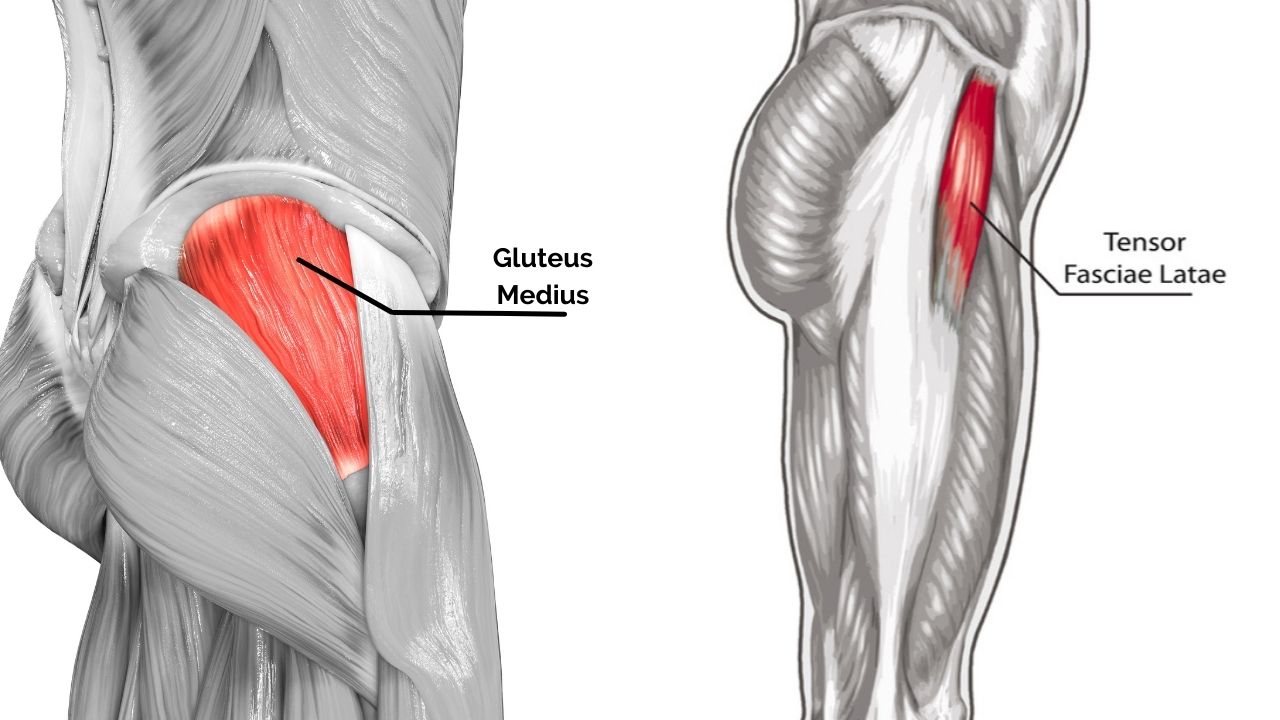Pain with hip internal rotation? Here’s what to do about it.
Jul 22, 2024
You figured it out. The reason your hip hurts is because you have limited hip internal rotation. But nothing that you do seems to improve it.
How are you supposed to improve hip internal rotation when this movement causes pain? By attacking it through multiple methods.
Using passive stretching but also strengthening. With isometrics and dynamics. You have to figure out what your body responds to best, right now. In this article, I’ll provide some tips to help you improve internal rotation in your hips, pain-free.
What muscles internally rotate the hip?
The main muscles that internally rotate the hips include the tensor fascia latae (“TFL”), gluteus medius and gluteus minimus. The adductors also assist in internal rotation but I recommend focusing on the muscles on the side of the hip first.

All movements in the body are generated through primary muscles and secondary muscles. The primary muscles are the main movers. In other words, they are the star of the show. For hip internal rotation, the primary movers are the gluteus medius and the TFL.
Why do you feel hip pain with internal rotation?
Restriction and pain in hip internal rotation seems to be an epidemic in today’s hips. I experienced this with my own hips years ago and now I see this with many of my students.
This might be groin pain with internal hip rotation. Or it can be more in the front of the hip when the pain arises with hip flexion and internal rotation. Others will feel it in the side of the hip more or even in the lower back/ql area.

The pain patterns vary greatly depending on the individual. But the reason for the pain is usually the same. The hips cannot access internal rotation safely and efficiently. There is some restriction or weakness when going into hip internal rotation. The nervous system does not feel safe and sends pain signals into our awareness.
How to improve hip internal rotation.
To improve hip internal rotation, we need to build strength and/or flexibility in this movement pattern. But we have to do it in a way that allows the body to feel safe. If we ignore the pain signals and try to “push through,” our bodies won’t make the adaptations we want.
When clients tell me they can’t improve their hip internal rotation despite working on it for months or years, this is usually the reason. We need to respect pain but not fear it. Our bodies are smart and is sending us a warning message.
If we don’t have the right intention, it does not matter which exercise we use. It’s as good as useless. But if we pay attention to what our body is telling us. If we work with pain and not against it, we can start seeing the results we want.

How do you know which exercise to focus on first? Here are some helpful tips:
- The exercise should not cause too much pain. A little discomfort is ok. You want to be able to control the level of discomfort you experience.
- You want to feel like you’re improving somehow. With every set and every workout, you want to be increasing the range, getting stronger or progressing in some way.
- You understand what you’re trying to achieve. You are feeling what you are supposed to be feeling. An exercise is useless if you don’t understand why you’re doing it.
Hip Internal Rotation Exercises
Step 1 - Build basic strength
Muscles need to be strong in order to be flexible. The first step is building basic strength in the primary and secondary movers for internal rotation.
This is not a complicated process but it does take time. You can't rush building strength. It takes as long as it takes. If you're an adult (over 25) then I recommend you choose a few tried and true lower body strength exercises and perform them once a week.
Great lower body strength exercises that target the internal rotators include lunges, squats and bulgarian split squats. Experiment with one and see how it feels for you.
It's important to progressively overload every week. This means you add more volume in the form of reps or weight each week. This is the only way your hips will get stronger.
Step 2 - Practice hip internal rotation on off-days
You can't work on strength everyday but that doesn't mean you can't practice the movement everyday. When you check in like this everyday or so, you can see how much your internal rotation is improving in response to the strength work.
If you don't use it, you lose it. Going into the ranges you already have is a great way to teach the brain that this movement is safe and it will further encourage the nervous system to open up.
Step 3 - Stretch
This should be the last step even though people routinely treat it as the first step. Stretching weak muscles is sort of like getting a salad on the side of a Philly Cheesesteak when you're trying to lose weight.
Sure, it's better than fries but it won't really get you to where you want unless you change your diet more dramatically - like eating less Philly Cheesesteaks.
Stretching will help you get more flexible in hip internal rotation once you've built some basic strength. Once you do, you can integrate various modes of stretching including dynamic, passive and isometric.
I recommend starting with passive stretching as I demonstrate above.
Conclusion
There are two somewhat competing forces here. The first is convincing your brain and nervous system that hip internal rotation is a safe and healthy movement. This is more of a psychological and behavioral intervention.
The second is the objective and practical way to improve hip internal rotation. If emotions and fears are removed, you build more range in hip internal rotation the same way as any other movement.
- Build strength;
- Practice the movement; and
- Stretch.
In my experience working with hundreds of students, the first part is MUCH more challenging. Building range takes patience. Emotions don't understand patience. They want results now.
But of course, this is irrational. Moving and feeling better takes time and practice. This is why I always recommend you address the pain-brain first or at the very least simultaneously with your movement practice.

